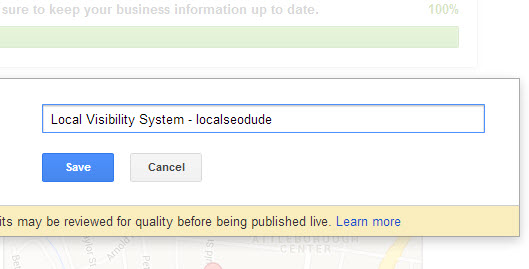In February, Google started allowing you to add a “single descriptor” to your Google Places page – that is, a word or short phrase that isn’t part of your business name.
It’s a huge departure from Google’s old policy, which was that you must use your legal or “offline” business name. There couldn’t be any embellishment.

For example, under the old rules, if your business was called “Jones & Jones,” that’s what you had to put in the “business name” field of your Google Places page. Now, it could be “Jones & Jones Roofing” or “Jones & Jones Bankruptcy Law.”
This rule-change is 30% opportunity and 70% problem. To dig into the implications, read this post by Mike Blumenthal, this thread on Linda Buquet’s forum, and watch minutes 44-49 of this MaxImpact (then watch the whole thing).
I’d like to focus on how I’d suggest using a “descriptor,” if you’re considering it.
Do NOT take any of this for gospel. My pointers are based entirely on what I’ve observed with a handful of clients who’ve used descriptors over the past couple of months.
I’m also not saying you should or should not use a descriptor for your business. That’s for you to decide.
A few other things to keep in mind:
- This is Google’s house. Google’s rules.
- The rules can (and probably will) change.
- The rules are unclear.
Anyway, here are my personal descriptor dos and don’ts (in no particular order):
1. Strongly consider adding a descriptor if there is a practical, non-SEO-related reason to do it. For example, it’s probably worth trying if you have multiple locations you’d like to differentiate, or if the name of your Google Places is “Dr. John Doe,” or it simply gives no indication of what you do. I guess don’t rule it out if rankings are your sole reason for adding a descriptor; just be more cautious (and paranoid).
2. The fewer words, the better. It’s true that Google is unclear about how many words constitute a “descriptor.” But don’t assume it’s a free-for-all – or that you’d even benefit from stuffing in multiple words.
3. Don’t change all your citations to match your tweaked Google Places name. Google should be able to recognize that they all refer to the same business. Also, if (when?) Google does another 180, you’ll want to avoid having to change all your citations again.
4. Don’t keep messing with the descriptor. No, it’s not set in stone. But any change in rankings will probably take a couple of weeks to happen. Also, for all we know, Google might penalize you for trying on 10 descriptors like they’re pairs of shoes.
5. Put the descriptor at the end of your name. Don’t perform surgery on your whole name by reshuffling the words. That’s more likely to mess up your citation-consistency.
6. Using your city name as the descriptor probably doesn’t make sense unless you’re multi-location. Also, if you’ve done the proper work on your citations and you have your NAP on every page, Google almost certainly knows where you’re located.
7. It should be a “keyword” or a city name, but not both. That’s more likely to look spammy to Google.
8. Do all the local SEO work you were going to do anyway – even if your rankings get a bump from the descriptor. Otherwise your rankings are like Bill Murray’s character in Stripes before he joins the Army.
9. First make sure your Google Places listing is live – findable when you search for it by name. That gives you a baseline of where you are without the descriptor. If your listing isn’t even publicly visible, you have no way of knowing what effect the descriptor might have. And if you suspect a penalty, you also wouldn’t know what’s causing your listing to be penalized.
10. If you have multiple locations, it’s probably not wise to use a “descriptor” for all of them at once. See what happens when you try it for one or a couple of locations. Dip your toes in the water.
11. If you’re an SEO and you want to try the descriptor, ask your clients first! Tell them the risks – even if they’re the ones who suggested it in the first place.
—
What’s been your experience with the “descriptor” so far?
What are your questions? Concerns?
Leave a comment!
